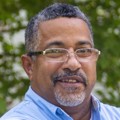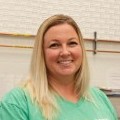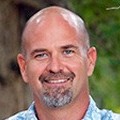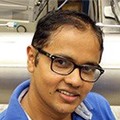CEBAF Operability Manager maintains a complicated relationship with advanced technology
Shawn Frierson knows how to use technology to help his team patch things up and keep them running— and the more than 1,800 nuclear physicists who come to the lab to conduct their research depend on him to be exacting and efficient. The former high school physics teacher has spent 16 years on the job refining his knowledge of the lab’s machinery and corresponding technologies, yet he still says the most important tools available to him are a solid understanding of fundamental concepts and his “rudimentary” scientific calculator.
Currently, Frierson is the Operability Manager for the Continuous Electron Beam Accelerator Facility (CEBAF). CEBAF is a DOE Office of Science user facility. As a keystone of the lab, CEBAF comprises a major portion of the facility’s annual operating budget and is used by nuclear physicists from 39 countries and 324 institutions. CEBAF is located 25 feet underground inside a ten-foot-tall, track-shaped tunnel that is one kilometer around.
In short: Frierson is at the helm of that responsibility for maintaining this massive facility with millions of individual parts, components and systems.
“We use CEBAF to speed up electrons within a beam that travels around our facility at close to the speed of light,” Frierson explained. “We send beams to our four experimental halls—Halls A, B, C and D.”
Once an electron is fired, it will travel around the track up to five and one-half times in about 22 millionths of a second before hitting the nuclei inside a target. Targets may be any element, such as hydrogen or lead, in any state of matter—solid, liquid or gas. The type of target is dictated by the experiment being conducted. Researchers then use a variety of detectors to track, record and observe the struck particles.
Undisturbed CEBAF runtime is a high-value commodity
Frierson understands that nuclear physicists may wait years to run an experiment using CEBAF. He says his ultimate goal is to keep CEBAF running smoothly during the full planned run cycle.
“Right now, we run about 33 weeks out of the year, 24/7,” he said. “We have teams working in eight-hour shifts around the clock during that time to monitor all systems and troubleshoot issues that arise.”
To minimize downtime during an experiment, Frierson relies on in-system monitoring tools that relay real-time data to an array of computer applications that help track the health of CEBAF.
“With all of the wear and tear on CEBAF during our run cycles, sometimes something will break that can cause our program to grind to a halt,” he explained. “At that time, you’re getting folks together, and you’re pulling diagnostic data from your systems to figure out how to fix it.”
This is where Frierson’s applications help to efficiently pinpoint the source of a problem.
“Our monitoring systems take data from all aspects of the machine during an experiment,” Frierson said. “For instance, while running this electron beam for 24 hours, there are times where a component may act up, and the electron beam could trip off. Maybe the component misbehaves because of the beam, which should be in our vacuum-sealed pipes, gets disturbed by air molecules. Or, it could be that a magnet misbehaves and mis-steers the beam.”
Frierson uses this software not only to monitor real-time events, but also to track activities affecting various components of CEBAF.
“We use that data to build charts and graphs that we then use to predict what issues may come up. With that knowledge, I can make recommendations regarding aspects of the system that may need attention during scheduled downtimes. I also use those reports to inform the groups about their equipment,” he said.
Understanding fundamental mathematical concepts is “best tool”
While Frierson relies heavily on technology with built-in mathematical formulas to be exacting in his work, there was a time when Frierson shunned even the simplest of tools in favor of pen, paper and brain power. Even with access to advanced technology, Frierson explained that he often prefers cranking out calculations by hand.
“Most of the calculations that I have to do are on paper, and I may throw a small calculation into my calculator,” he said.
Frierson’s preference for applying simple tools to his deep understanding of a concept came about when he was young.
“When I was in high school, I was taking algebra two and trigonometry and we were required to have one of those big, complicated calculators,” Frierson remembered. “My chemistry teacher asked me what I was doing with the massive graphing calculator, and he pulled out a more rudimentary calculator that he used for chemistry. I learned that if you understand the fundamentals, then you understand what the computer would be doing, and you don’t need it.”
Frierson learned, too, that using a graphing calculator can make it difficult to identify errors.
“When you write everything out, you can easily find errors and tell the story of how you got your answer,” he explained. “When I got into physics, it was the same thing. Most of that work that you’re going to be doing is going to be on paper.”
Frierson used these simple tools to earn a bachelor’s degree in physics from Old Dominion University, followed by a master’s degree in physics from the University of Oklahoma. He later also earned a master’s degree in optical engineering from Norfolk State University.
Before coming to Jefferson Lab, he said he taught “some of the best and brightest students in the area” at the Math and Science Academy at Ocean Lakes High School in Virginia Beach using mathematical fundamentals, pen, paper and that rudimentary calculator.
“I thought teaching was my calling before I came to the lab,” Frierson says. “I taught my students that your greatest tool is your understanding of the concepts. External to that, you’re talking paper, pencil and a simple calculator.”
For Frierson, that continues to hold true even as the Operability Manager of one of the world’s most advanced scientific facilities.
By Carrie Rogers









































